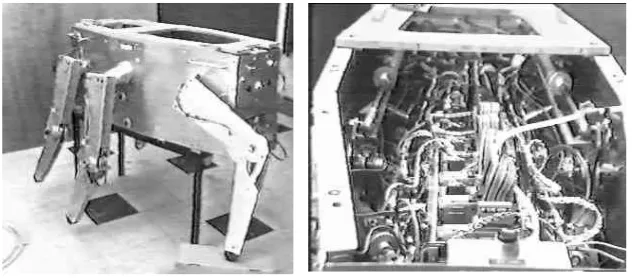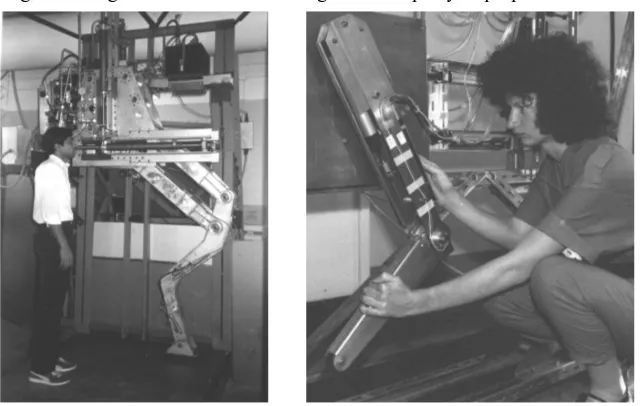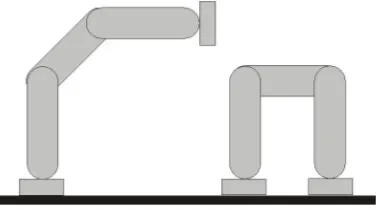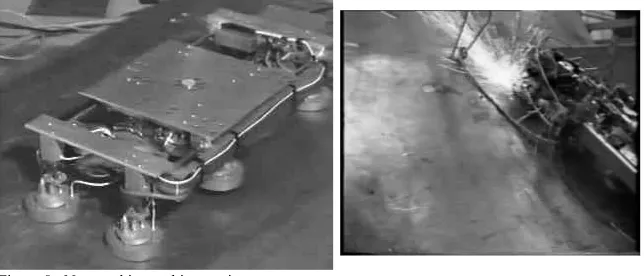1
JOHN BILLINGSLEY University of Southern Queensland
Toowoomba, Australia
Reminiscences cover over two decades of legged robot research. From Robug I, a six-legged walker that was overweight, the story leads through a succession of wall-climbers both simple and elaborate, some of which have found commercial applications in the nuclear industry.
1. Introduction
The robotics research lab of Portsmouth Polytechnic, as it was then, was transformed in June 1985. Of course, work on the Craftsman Robot and manufacturing cells continued, but in that month Arthur Collie joined the Group with a Royal Society grant to indulge his passion for legged robotics. The first project resulted in Robug I, an overweight six-legged machine with a body in the shape of a coffin. Later robots such as Robug II were designed with weight very much in mind, although they still favoured pneumatic actuation.
While some projects pursued intelligence (or rather cunning), others such as Zig-Zag sought to improve mechanical simplicity. However the nature of the research was transformed when the nuclear industry took an interest.
Early collaboration with Arthur had been through his role as Development Manager of Turnright Controls Ltd, part of the Tube Investments Group. The interest then had been in controls for domestic cookers, a far cry from walking robots. A realignment of the Tube Investments structure led to a management buy-out and Turnright’s transformation into a new company, Portsmouth Technology Consultants, or PorTech for short.
The new company needed products to sell. When the nuclear industry expressed a readiness to place an order for a robot to enter a reactor, the opportunity was seized and a succession of Neros resulted.
Within a year, Michael Bellmann had completed Hydra, a ‘somersaulting’ wall-climber. Michael Rook developed the Toad for his master’s degree and by 1997 Sam Cubero had completed STIC, a lightweight four-legged ceiling-walker.
Some projects are waiting in limbo, half completed. Nantha Kumar’s roller-skating robot still occupies considerable space in the lab, but is a striking icon that gets photographed on Open Days.
Graham McLatchey has pulled most of the legs off Robug 4, which we scavenged from the demise of Portech a few years ago. He is seeking to improve the efficiency of the actuation, but will present his own account of it.
2. The first Robug
We did not enter the task blindly.
[image:2.595.135.451.440.579.2]Arthur's funding was by the Royal Society under their industrial fellow ship scheme, an innovative to increase the exposure of universities to industry. The fellowship gave the full facilities of the Royal Society for its two-year duration, paying his salary at a reduced amount. Funding for the project itself came from SERC. Arthur relates that the SERC representative said, very grudgingly, "I suppose under the circumstances we shall have to give you a grant."
Figure 1. Robug 1 was shaped like a coffin, filled with circuit boards
Accordingly we set off to inspect the DARPA legged robot in Columbus, Ohio. Some massive engineering brute force made the task look easy. It was not.
[image:3.595.133.453.268.471.2]Robug I's body was shaped rather like a coffin. Inside it, six single-board BBC Micros (the embedded processor of choice at that time) provided the computing power, one for each leg. It is interesting to compare the sizes of trial legs of Robug and DARPA. Their budgets were equally disproportionate.
Figure 2. Legs of different sizes, DARPA and Robug I
Since it must be self-powered, it was intended that pneumatic power should eventually be provided by an explosive gas generator and an accumulator. Pneumatic actuation would also give the compliance that would allow the load to be shared evenly between the legs.
Much was learned from Robug I. Compliance and stability are uneasy bedfellows. Without an inertial sensor, Robug's early steps were somewhat faltering. We also learned how easy it is to underestimate the load each leg would have to bear, not only from movement of the centre of gravity but also from inertial forces.
young lady in question that using an Allen key to tighten the sensor's grubscrew would have been an altogether better solution.
3. Robug II
[image:4.595.141.457.327.474.2]In 1988, another grant allowed the work to continue. Armed with plenty of hindsight, we aimed for low weight. To improve stability, the robot followed an insect-based scheme with its knees higher than its centre of gravity. Wall-climbing looks more dramatic than walking, but it allows stability to be simplified even further. A "Shufflebottom" version with two arms/legs with pneumatic grippers, mounted on a base with two more suckers, showed that the principle worked. Another two legs were added to make the full Robug II.
Figure 3. Shufflebottom and Robug II
With 'belly suckers' augmenting the legs, a strange but safe gait was possible. Each foot was released and advanced in turn, then the body was released and heaved forwards. Strategies of exploring for a safe foothold impressed the viewers of BBC Television's 'Tomorrow's World'.
[image:4.595.136.451.516.660.2]We then wanted to make a transition from floor to wall, or from wall to ceiling, so the body gained a hinge so that the front part could rear up. Bing Lam Luk joined the project and took the software in a new direction.
4. Zig-Zag
[image:5.595.139.445.344.585.2]A single pneumatic cylinder flexes a square jointed frame to become a rhombus. Four suckers at the corners hold it to a wall. The grippers on one side are released, the shape is flexed and Zig-zag has taken a step. Arthur boasted this as the simplest form of walking robot. However it has the disadvantage that the unattached corners merely 'flop' against the wall and it cannot operate on an overhang. Nevertheless in 1990 Arthur and Bing were proud to take it to the first Robot Olympics, where it won its event on a high vertical wall.
Figure 5. Zig-zag with Arthur and Bing at the 1990 Robot Olympics
5. Hydra
ankles, then straighten into a series of 'flicflac' somersaults that would take it across the floor. The addition of swivelling joints in the 'ankles' would give navigation and with careful positioning the Hydra could transfer to a wall.
Figure 6. The principle of Hyda
Michael Bellmann joined me in Toowoomba and within months Hydra was completed as part of his project work for TU Muenchen.
6. Toad
I wanted a more versatile competitor for Zig-Zag and the result was Toad. To front suckers are mounted at the ends of a horizontal bar. Two rear suckers are mounted at the ends of a second bar. The two bars are joined by a link that can be extended or shortened by a pneumatic cylinder.
Figure 7. Toad I, and a simpler version running on the ceiling on Tomorrow's World
[image:6.595.142.453.475.622.2]Some simulation showed that the rear pivot of the cylinder must be behind the feet to ensure that the rear legs are stable in lining up with the front ones. Extra actuation was added to twist the link, so that when a foot is released it can be actively lifted or pressed against the surface to take a new grip.
Michael Rook developed the machine for his Master's project, and Tomorrow's World viewers saw a Toad running across the studio ceiling.
7. Nero
Meanwhile in England, Portech had taken up the challenge of making a robot for the nuclear industry. The first robot task was to climb on a reactor pressure vessel in order to put a line of temperature sensors in place and Nero I had this single purpose.
Whereas we had struggled to incorporate intelligence into Robug, the last thing the clients wanted was a robot that moved on its own initiative. Each pace must be verified by an operator. If a mishap occurred and the robot had to be retrieved by a human, reactor shut-down costs would amount to six figures.
[image:7.595.137.459.469.607.2]The design was in the form of two rectangular frames, each with a gripper at each corner. One was long and thin, inside which a carriage could move up and down. The second was square, also carried four grippers, was mounted on the carriage and could be made to swivel. Frames were released and lifted in turn, while the carriage operated either to carry the smaller frame forward, or the larger frame if that was lifted.
Figure 8. Nero and its working environment
8. STIC
[image:8.595.187.354.229.367.2]Sam Cubero was determined to make a rival for Robug, to be lighter and more agile. Once again the actuation was to be pneumatic.
Figure 9. Sam Cubero proudly demonstrated STIC
A vital part of the control was in the valves used to control the cylinders. Poppet valves released huge amounts of air as they controlled pressure with mark-space operation. Could a proportional gas valve be devised that would permit more sophisticated control? A combination of the Coanda effect and planar solenoids seemed to be the answer. Indeed STIC walked on a ceiling, rather more steadily than on a floor, and is now in retirement in Sydney's Powerhouse Museum.
9. Robugs III and IV
The collaboration between Portech and Portsmouth University now gained strength with two major projects from the European Community. To some extent, the Robugs were seen as a demonstrator for a new communication protocol. Robug IV has two dozen processors, three for each of its eight legs.
Figure 10. Robug 4
[image:8.595.202.346.549.642.2]finances were found to be no longer viable. The consolation was that we were able to buy Robug IV for the University of Southern Queensland.
With eight legs, concerns for the robot's 'standing strength' should be minimal. Indeed there is video of someone sitting on Robug III. However weight was not so strictly constrained and when operated at a laboratory pressure of 4 bar, as opposed to the design pressure of 10 bar, actuator force again becomes an issue. Graham McLatchey has been working on solving it.
10. Conclusion
As robots become more commonplace, public interest is waning. Autonomous vacuum cleaners and lawnmowers have not taken the market by storm. When a robot has legs, however, it still seems to keep its cachet. Walking and climbing robots will continue to be great fun for many years.
Acknowledgment
Arthur Collie has given me substantial help in refreshing my memory of those early days. Bing Luk has also retained an archive.
References
1. The development of a pneumatically powered walking robot base, A A Collie, J Billingsley, L Hatley, Proc IMechE C377/86, Conf. UK Research in Advanced Manufacture, London, Dec. 1986, pp137-143.
2. Design and performance of the Portsmouth climbing robot, A A Collie, J Billingsley, S F Mo, E von Puttkamer, Proc 7th International Symposium on automation and robotics in construction, June 1990, Bristol.
3. Design and performance of the Portsmouth climbing robot, A A Collie, J Billingsley, S F Mo, E von Puttkamer, Mechatronic Systems Engineering, 1, pp 125-130
4. A climbing robot with minimal structure, J Billingsley, A A Collie, B L Luk, Proc IEE conference Control 91, March 1991, Edinburgh, 2, pp 813-815. 5. Robug II: an intelligent wall climbing robot, B L Luk, A A Collie, J
Billingsley, IEEE conference on Robotics and Automation, April 1991, Sacramento, USA, pp 2342-2349.
6. Real time software control system for the Nero wall-climbing robot, B L Luk, A A Collie, J Billingsley, T White, N Bevan, Proc 4th Euromicro Workshop on Real Time Systems, Athens, June 1992, pp 74-78
8. An Articulated Limb Climbing Vehicle with Autonomous Floor to Wall Transfer Capability, B L Luk, A A Collie, N Bevan, J Billingsley, Proc 1st IFAC International Workshop on Intelligent Autonomous Vehicles, Southampton UK, 18-21 April 1993, pp 20-24.
9. Toad - a wall-climbing robot, J Billingsley, M J Rook, A A Collie, Australian Robot Association Conference, Robots for Competitive Industries, Brisbane, July 14-16 1993.
10. Design Aspects of a Leg for a Walking Robot, J Billingsley, A Collie, Proc Mechatronics and Machine Vision in Practice, Toowoomba Australia, September 13-15 1994, pp 162-165.
11. Automatic surface transition adaptation for a quadrupedal space frame robot, S N Cubero, J Billingsley, Proc Second International Conference on Mechatronics and Machine Vision in Practice, Hong Kong, September 12-14 1995, pp 113-118.
12. A novel proportional gas valve for mechatronics applications, S N Cubero, J Billingsley, Proc Second International Conference on Mechatronics and Machine Vision in Practice, Hong Kong, September 12-14 1995, pp 179-184.
13. Command and compliance of a leg for a walking robot, J Billingsley, A A Collie, Proc Second International Conference on Mechatronics and Machine Vision in Practice, Hong Kong, September 12-14 1995, pp 256-259.
14. Automatic control of a surface adapting, four legged wall climbing robot, S J Cubero, J Billingsley, Mechatronics 96 With Mechatronics & Machine Vision in Practice 96, University of Minho, Geuimaraes Portugal, September 1996 pp 1.135-1.142.
15. S Cubero, J Billingsley, Force, Compliance, and Position Control for a Space Frame Manipulator, 4th Mechatronics and machine vision in practice, Toowoomba; Australia, Sep 1997. pp. 124-130.
16. N K Kanesen, J Billingsley, A Roller Skating Robot, Mechatronics and Machine Vision, Research Studies Press, England, September 2000, ISBN 0-86380-261-3, pp 283-292.






